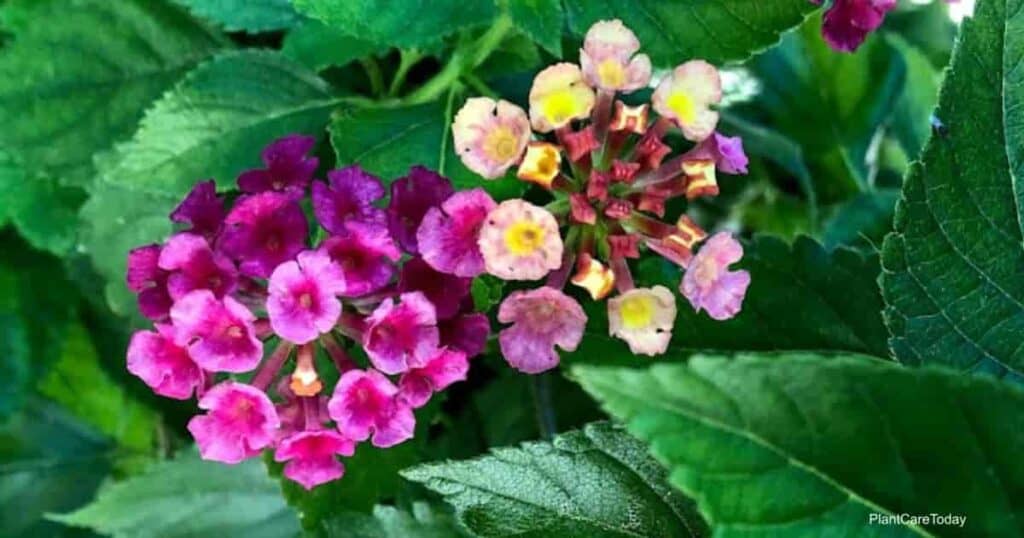Lantanas, aka shrub verdanas, are popular flowering plants belonging to the Verbanacaea family. Perfect if you want to attract bees, butterflies, and hummingbirds in your garden.
The genus includes around 150 species and many variants and cultivars. Their native tropical ranges are in tropical regions of the Americas and Africa.

Though recognized as an invasive species in some places like California, Florida, Hawaii, and Texas, it is hard to resist its dark green foliage and nectar-rich flower clusters.
The one downside to these plants, especially for those new to the genus, is the contradictory information found all over the web.
Often these contradictions lead to an individual species. Or, more commonly, sellers may market Lantana plants as either annuals or perennials with colors in yellows, orange, and purple.
But which is it?
Is Lantana a Perennial?
The short answer is yes.
The long answer is that your lantana will either be perennial or annual based on where and how you grow it.
What Are Annuals and Perennials, Anyway?
There are three lifespan categories for plants.
- Annuals need replanting every year, as they only live for a single growing season.
- Biennials have a 2-year lifespan. Yet many biennial crops and herbs (carrots, kale, parsley, etc.) get harvested well before this point.
- Perennials are anything that lives for longer than two years, be it 3 years or 300.
In the case of lantanas, they’re perennial in their native habitat. But, heavy frost may kill them, making them an annual in other regions.
So depending on where you live, you can choose whether to grow your lantana as an annual or perennial.
How to Grow Lantanas as Perennials?
Lantanas are tropical plants and may be grown outdoors as a perennial in USDA hardiness zones 9 to 11.
They are heat and drought-tolerant and capable of withstanding salt spray, making them a suitable choice for planting near coastal areas.
Some variants and cultivars are a little cold-hardy. They can be grown as a tender perennial. This means they need insulating protection methods.
When grown as a perennial, these shrubs can grow between 2′ – 6′ feet tall and 3′ – 10′ feet wide, depending on the species.
To ensure the soil doesn’t compact over time, plant them in loose, well-drained soil. Augment it with coarse sand or similar aggregate.
For the best blooms, plant where there is full sun to light shade or dappled sunlight. The sun’s intensity in midsummer will tell you if it needs noon protection.
If you live in an area with animals, you do not need to worry. Lantana is commonly regarded as resistant to deer and rabbits because of its pungent scent and unpleasant taste deterring these animals from being attracted to it.
Give your lantana a balanced flower fertilizer as instructed on the package. Stop fertilization 2 months before the first frost is due. Otherwise, new and tender growth will be vulnerable.
In USDA zones 1 to 8, you can plant them in containers, bringing them inside before the first frost hits.
Find a nice, sunny window to keep them by during the winter when grown in this manner.
Ensure the plant is inaccessible to children and pets, as the entire Lantana plant is toxic. The berries can be fatal if ingested.
Normal indoor conditions will generally be enough to allow the plant to overwinter safely.
How to Grow Lantanas as Annuals?
Growing lantana outdoors in colder zones will kill it before the winter is over.
You can then remove the dead leaves, stems, and roots, planting a new one the following year.
Care is typically the same, and your lantana will remain smaller during its shortened lifespan, only reaching up to 4′ feet tall and 3′ feet wide.
Plan your garden spacing accordingly. Or pot the plant in an outdoor container for a smaller but no less impressive display.
Select a location within your garden that gets a minimum of 6 to 8 hours of direct sunlight daily. They go nicely along with patios or entryways.
Which Method is Better?
Whether you grow your lantana as an annual or perennial is a matter of personal preference or zone limitations.
In warmer zones, perennials make for a beautiful, low-maintenance display. But they might become difficult to move at full size when kept in containers.
In regions with colder climates, it is cultivated as an annual plant or sometimes even kept as an indoor houseplant.
Meanwhile, annuals are more compact, and you get to reuse the space each year for new lantana or some other plant. It is perfect for people who like to change things up occasionally.
It also means you don’t have to worry about having enough space to keep the plant inside, especially if you’re worried about its strong odor.
Regardless if you decided whether it is annual or perennial, always watch for signs of insect infestations such as aphids, spider mites, whiteflies, and lace bugs.
If lantanas are placed in excessively damp regions, there is a higher likelihood of encountering issues such as powdery mildew and root rot.
